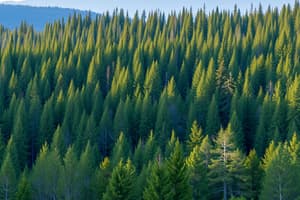Podcast
Questions and Answers
Why is biodiversity lower in coniferous forests compared to rainforests?
Why is biodiversity lower in coniferous forests compared to rainforests?
Harsher, colder circumstances make conditions for life much less favorable in coniferous forests than in rainforests.
Where is the coniferous forest biome primarily located in North America?
Where is the coniferous forest biome primarily located in North America?
Canada and Alaska
What is the temperature range experienced by the coniferous forest biome?
What is the temperature range experienced by the coniferous forest biome?
92 degrees F (50 degrees C)
What are the two layers of the coniferous forest biome?
What are the two layers of the coniferous forest biome?
What function do cones have in the life cycle of a coniferous tree?
What function do cones have in the life cycle of a coniferous tree?
Why is being an evergreen a good adaptation for conifers?
Why is being an evergreen a good adaptation for conifers?
What two characteristics of needle- or scale-shaped leaves help conifers conserve water?
What two characteristics of needle- or scale-shaped leaves help conifers conserve water?
What is the difference between migration and hibernation?
What is the difference between migration and hibernation?
How does the shape of a conifer tree help it shed heavy snow?
How does the shape of a conifer tree help it shed heavy snow?
What climate characteristics does the coniferous forest biome experience?
What climate characteristics does the coniferous forest biome experience?
In which areas are coniferous forests primarily found?
In which areas are coniferous forests primarily found?
How many forest layers are present in the coniferous forest biome?
How many forest layers are present in the coniferous forest biome?
What adaptations do plants in the coniferous forest biome have to resist fire?
What adaptations do plants in the coniferous forest biome have to resist fire?
What is hibernation?
What is hibernation?
What adaptations help conserve energy for plants and animals in the coniferous forest biome?
What adaptations help conserve energy for plants and animals in the coniferous forest biome?
What latitude range do coniferous forests typically fall within?
What latitude range do coniferous forests typically fall within?
What is the function of the thin, needle-like leaves produced by conifers?
What is the function of the thin, needle-like leaves produced by conifers?
What is an example of animal adaptation in the coniferous forest biome?
What is an example of animal adaptation in the coniferous forest biome?
What adaptations do animals have for survival during harsh conditions?
What adaptations do animals have for survival during harsh conditions?
Flashcards are hidden until you start studying
Study Notes
Biodiversity in Coniferous Forests
- Coniferous forests have low biodiversity due to harsher, colder conditions compared to rainforests.
- Limited number of organisms can survive in less favorable environments.
Location of Coniferous Forests
- Primarily found in Canada and Alaska in North America; extensive areas in northern Europe and Russia.
- In northern Canada, known as boreal forests; in Russia, referred to as taiga.
- Located between 50 to 70 degrees north latitude, far from the equator, resulting in colder temperatures and limited sunlight.
Climate Characteristics
- Experiences the widest range of temperatures of any biome; summers are short (1-3 months) and average 70°F (20°C).
- Winters can be extremely cold, averaging -22°F (-30°C); overall precipitation averages around 20 inches (500 mm) per year.
Forest Structure
- Consists of two primary layers: the canopy (top layer with tallest trees) and the understory (smaller trees and shrubs).
- The thick canopy reduces sunlight, leading to low understory growth and decreased biodiversity.
Plant Adaptations
- Dominant plant life are conifers (e.g. pine, spruce, and larch), which reproduce using cones instead of energy-intensive flowers.
- Conifers retain their needle-shaped leaves year-round (evergreen), conserving energy and water.
- Needle-shaped leaves are coated with a waxy substance, minimizing water loss.
Animal Adaptations
- Animals in this biome adapt to extreme temperatures through migration (moving to different areas) or hibernation (entering a state of reduced activity).
- Winter-active species (e.g. ermine) develop warm coats and may change color for camouflage.
Additional Notes on Functionality
- Cones in coniferous trees contain seeds necessary for reproduction.
- Evergreen nature of conifers enables energy conservation by avoiding the annual energy cost of leaf production.
- The triangular shape of conifers allows for efficient snow shedding, reducing branch breakage.
Summaries of Key Aspects
- Temperature Range: Coniferous forests have extreme temperature fluctuations; summers are humid, and winters are severely cold.
- Location Summary: Found at high latitudes, primarily in Northern Hemisphere regions.
- Layer Structure: Simplest forest biome with only two layers due to low light and acidic soil limiting plant diversity.
Role of Fire
- Fire resistance is a significant adaptation for plants in this biome, which affects plant resilience and regeneration.
Terminology
- Taiga and boreal forest are synonymous with coniferous forests, referring specifically to their cold, northern locations.
- Latitude of this biome is specified as between 50 to 70 degrees north.
- Hibernation is defined as a reduced state of activity that aids in energy conservation.
Miscellaneous Facts
- Only two layers exist in the coniferous forest biome: canopy and understory.
- Adaptations such as evergreen leaves and hibernation are essential for energy conservation in challenging environmental conditions.
Studying That Suits You
Use AI to generate personalized quizzes and flashcards to suit your learning preferences.




